
17.05.2018
Conservation goes hand in hand with rising income in the Philippines
International Day for Biological Diversity: On the island of Panay the local people and the authorities are working together to protect the rainforest and improve living conditions.
Biological diversity, or biodiversity, is existential for humanity – and thus a basic precondition for sustainable development. The International Day for Biological Diversity, on 22 May, highlights this.
The Deutsche Gesellschaft für Internationale Zusammenarbeit (GIZ) GmbH supports partners around the globe in protecting ecosystems, and animal and plant species. The federal enterprise helped to have over 200 million hectares designated as protected areas between 2010 and 2015, as well as to conserve existing protected areas.
On behalf of the German Federal Ministry for the Environment, Nature Conservation and Nuclear Safety (BMU), for instance, GIZ is working on the Philippine island of Panay. Its unique rainforest offers a valuable habitat for species found only on the island. And it is the most important carbon sink in the region, which is a biodiversity hotspot.
GIZ is working closely with the Philippine Department of Environment and Natural Resources, local actors and the indigenous population to protect biodiversity in Panay’s forests in the long term. Since 2010, nine local authorities have designated protected areas covering a total of over 30,000 hectares. These areas have been integrated in land use plans. In addition, over 2,200 hectares have been re-afforested. More trees also store more greenhouse gases: thanks to the improved forest conservation measures, CO2 emissions have dropped by almost 64,800 tonnes a year. During the eight-year term of the project, over half a million tonnes of CO2 will thus be saved.
The local communities and households living in the forest are now also using more than 2,000 hectares of land for sustainable agriculture under the tree canopy, where they grow bananas, coffee and cacao. As a result of this careful use of the natural resources of the rainforest itself, and of the sustainable farming of almost 500 hectares around the forest, farmers in the region have seen their average annual income rise by around one third.
